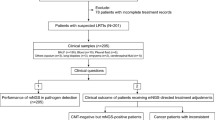Abstract
Bloodstream infections (BSIs) are a major cause of morbidity and mortality worldwide, and impose considerable costs on healthcare systems. A key predictor of clinical outcomes in patients with BSIs is the early initiation of appropriate targeted antimicrobial therapy. However, with conventional blood culture methods, the gold standard, there is a significant time delay of approximately 2–3 days before clinical results are available, with many patients receiving inappropriate and/or unnecessary antimicrobial therapy in the interim. During the past two decades, the use of in vitro assays that utilize nucleic acid amplification-based detection of pathogen-associated molecular patterns has led to a significant reduction in the time (hours vs. days with blood culture) to detection and identification of several of the causative pathogens of BSIs and, potentially, earlier initiation of targeted antimicrobial therapy. This review focuses on the properties and clinical use of one of these molecular diagnostic assays, the Verigene® Gram-Positive Blood Culture Nucleic Acid Test (BC-GP), which detects many of the potentially pathogenic Gram-positive bacteria associated with BSIs, including Staphylococcus spp., Streptococcus spp., Listeria spp., and Enterococcus spp., and specific resistance markers (mecA, vanA, and vanB). Based on more than 1,600 samples, there was a high degree of agreement between BC-GP test results and those obtained using conventional blood culture and assay methods, irrespective of whether samples were fresh or frozen, and a high degree of agreement for identification of mecA-mediated meticillin resistance in S. aureus and S. epidermidis organisms and vanA- or vanB-mediated vancomycin resistance in E. faecalis and E. faecium organisms.
Similar content being viewed by others
References
Paolucci M, Landini MP, Sambri V. Conventional and molecular techniques for the early diagnosis of bacteraemia. Int J Antimicrob Agents. 2010;36(Suppl 2):S6–16.
Wenzel RP, Edmond MB. The impact of hospital-acquired bloodstream infections. Emerging Infect Dis. 2001;7(2):174–7.
Bauer M, Reinhart K. Molecular diagnostics of sepsis: where are we today? Int J Med Microbiol. 2010;300(6):411–3.
Kost GJ, Tran NK, Louie RF, et al. Rapid diagnosis of sepsis: point-of-care testing, nucleic acid testing, and the value model. Point Care. 2003;2(3):163–71.
Lehmann LE, Herpichboehm B, Kost GJ, et al. Cost and mortality prediction using polymerase chain reaction pathogen detection in sepsis: evidence from three observational trials. Critical Care. 2010;14:R186.
Kumar A, Roberts D, Wood KE, et al. Duration of hypotension before initiation of effective antimicrobial therapy is the critical determinant of survival in human septic shock. Crit Care Med. 2006;34(6):1589–96.
Kumar A, Ellis P, Arabi Y, et al. Initiation of inappropriate antimicrobial therapy results in a fivefold reduction of survival in human septic shock. Chest. 2009;136(5):1237–48.
Huttunen R, Aittoniemi J. New concepts in the pathogenesis, diagnosis and treatment of bacteremia and sepsis. J Infect. 2011;63(6):407–19.
Septimus EJ, Kuper KM. Clinical challenges in addressing resistance to antimicrobial drugs in the twenty-first century. Clin Pharmacol Ther. 2009;86(3):336–9.
Gandhi TN, DePestel DD, Collins CD, et al. Managing antimicrobial resistance in intensive care units. Crit Care Med. 2010;38(8):S315–23.
Wallet F, Nseir S, Baumann L, et al. Preliminary clinical study using a multiplex real-time PCR test for the detection of bacterial and fungal DNA directly in blood. Clin Microbiol Infect. 2010;16(6):774–9.
Alahmadi YM, Aldeyab MA, McElnay JC, et al. Clinical and economic impact of contaminated blood cultures within the hospital setting. J Hosp Infect. 2011;77(3):233–6.
Dellinger RP, Levy MM, Carlet JM. Surviving Sepsis Campaign: international guidelines for the management of severe sepsis and septic shock 2008 (published erratum appears in Intensive Care Med 2008;36(4):1394–6). Intensive Care Med. 2008;36(1):296–327.
Zwang O, Albert RK. Analysis of strategies to improve cost effectiveness of blood cultures. J Hosp Med. 2006;1(5):272–6.
US FDA. Clinical Laboratory Improvement Amendments (CLIA). http://www.fda.gov/MedicalDevices/DeviceRegulationandGuidance/IVDRegulatoryAssistance/ucm124105.htm. Accessed 29 Nov 2012.
US FDA. Evaluation of automatic Class III designation (de novo) for Verigene® Gram-Positive Blood Culture Nucleic Acid Test (BC-GP). http://www.accessdata.fda.gov/cdrh_docs/reviews/K113450.pdf. Accessed 8 Oct 2012.
Buchan BW, Mackey T-L, Cahak C, et al. Rapid detection of Gram-positive bacteria and resistance determinants directly from positive blood cultures using the microarray-based sample-to-result Verigene BC-GP assay (poster no. P-1700). In: 22nd European Congress of Clinical Microbiology and Infectious Diseases, London, 31 Mar–3 Apr 2012.
Tormo N, Medina R, Ocete MD, et al. Performance of the nanosphere’s Verigene BC-GP test for rapid detection of Gram-positive bacteria and resistance determinants directly from positive blood cultures (poster). In: 22nd European Congress of Clinical Microbiology and Infectious Diseases, London, 31 Mar–3 Apr 2012.
Buchan BW, Mackey T, Cahak C, et al. Evaluation of the microarray-based sample-to-result Verigene BC-GP assay for rapid detection of Gram-positive bacteria and resistance determinants directly from positive blood cultures (abstract). In: 51st Interscience Conference on Antimicrobial Agents and Chemotherapy, Chicago, 17–20 Sep 2011.
Anderson C, Kaul K, Voss B, et al. Evaluation of the Verigene Gram-positive blood culture test (BC-GP) (poster no. 1163). In: 112th American Society for Microbiology General Meeting, San Francisco, 16–19 Jun 2012.
Disclosure
The preparation of this review was not supported by any external funding. During the peer review process, the manufacturer of the diagnostic assay under review was offered an opportunity to comment on the article. Changes resulting from comments received were made by the author on the basis of scientific and editorial merit
Author information
Authors and Affiliations
Corresponding author
Additional information
The manuscript was reviewed by A. Mencacci, University of Perugia, Department of Experimental Medicine and Biochemical Sciences, Microbiology Section, Perugia, Italy; D.S. Perlin, Public Health Research Institute and New Jersey Medical School-University of Medicine and Dentistry New Jersey, Newark, NJ, USA; P.F.G. Wolffs, CAPHRI, Maastricht University Medical Center, Department of Medical Microbiology, Maastricht, The Netherlands.
Rights and permissions
About this article
Cite this article
Scott, L.J. Verigene® Gram-Positive Blood Culture Nucleic Acid Test. Mol Diagn Ther 17, 117–122 (2013). https://doi.org/10.1007/s40291-013-0021-z
Published:
Issue Date:
DOI: https://doi.org/10.1007/s40291-013-0021-z




